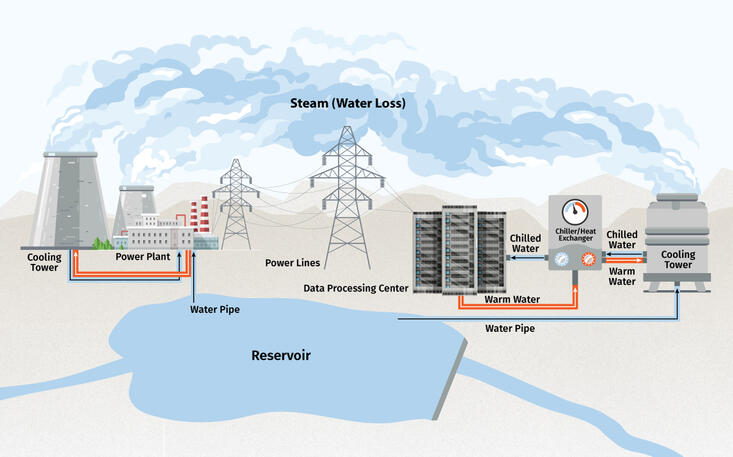2023-04-28 カリフォルニア大学リバーサイド校(UCR)

Data processing centers consume water by using electricity from steam generating power plants and by using on-site chillers to keep their servers cool. Graphic image by Evan Fields/UCR
このことから、AIの使用は深刻な淡水不足を引き起こす可能性がある。サーバーの冷却や電力生産に必要な冷却塔などが水を大量に消費しているため、AIモデルのトレーニングは約700,000リットルの水を消費する。
大手テック企業は、自らの水の使用量を削減する責任があると指摘されている。AIモデルのトレーニングは、水蒸気が蒸発しにくい涼しい時間に行うことで、より効率的な水の使用が可能である。
<関連情報>
- https://news.ucr.edu/articles/2023/04/28/ai-programs-consume-large-volumes-scarce-water
- https://arxiv.org/abs/2304.03271
AIをより “渇き “のないものにする: AIモデルの秘密のウォーターフットプリントを発見して対処する
Making AI Less “Thirsty”: Uncovering and Addressing the Secret Water Footprint of AI Models
Pengfei Li, Jianyi Yang, Mohammad A. Islam, Shaolei Ren
arXiv Submitted on: 6 Apr 2023
DOI:https://doi.org/10.48550/arXiv.2304.03271
The growing carbon footprint of artificial intelligence (AI) models, especially large ones such as GPT-3 and GPT-4, has been undergoing public scrutiny. Unfortunately, however, the equally important and enormous water footprint of AI models has remained under the radar. For example, training GPT-3 in Microsoft’s state-of-the-art U.S. data centers can directly consume 700,000 liters of clean freshwater (enough for producing 370 BMW cars or 320 Tesla electric vehicles) and the water consumption would have been tripled if training were done in Microsoft’s Asian data centers, but such information has been kept as a secret. This is extremely concerning, as freshwater scarcity has become one of the most pressing challenges shared by all of us in the wake of the rapidly growing population, depleting water resources, and aging water infrastructures. To respond to the global water challenges, AI models can, and also should, take social responsibility and lead by example by addressing their own water footprint. In this paper, we provide a principled methodology to estimate fine-grained water footprint of AI models, and also discuss the unique spatial-temporal diversities of AI models’ runtime water efficiency. Finally, we highlight the necessity of holistically addressing water footprint along with carbon footprint to enable truly sustainable AI.



